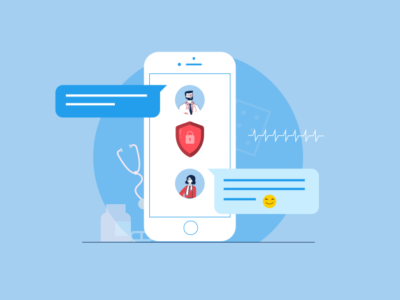Computer network assaults have the potential to severely disrupt company operations and cause financial losses. If an organization’s data, networks, or systems are attacked, it should immediately implement preventive measures. Visit www.blueshiftcyber.com for a detailed list of potential measures, information on cyberattacks, and information on how Blueshift Cyber assists organizations in protecting their data. The following are some examples of cyberattacks that enterprises should be on the alert for:
Ransomware
Cybercriminals use ransomware, a dangerous kind of virus, to take control of your computer and encrypt the data stored on it. After encrypting the data, the attacker will demand money in order to decode it. Malicious email links and attachments are a typical method for malware to spread. Less common assaults, on the other hand, may be carried out by exploiting unpatched operating system faults. The harmful software known as ransomware has the power to severely damage your company by interfering with its ordinary operations and demanding a ransom payment of several thousand dollars. The two most important things are to keep all of your software up to date and to practice good cyber hygiene. As a potential solution to this problem, avoid clicking any links supplied to you by unknown senders. Furthermore, having a solid backup system in place can help to ensure that your data can be recovered in the event of an attack.
Phishing
Phishing schemes are a kind of cyberattack in which a person or company is selected as the target and fooled into providing personal information or making a financial donation. Typically, the perpetrator will contact the victim by email, text message, or other form of communication with a message that seems to be from a reputable entity, such as a bank, company, or government body. It is conceivable that the email contains hazardous files or links to dangerous websites.
If you are participating in a questionable discussion, you should avoid opening any attachments or clicking on any links. Verify the message’s origin by contacting the organization directly, either by phone or via their official website.
Personal information, such as passwords, credit card numbers, and Social Security numbers, should never be sent over email or text message. Password sharing falls within this category. If you come across any strange emails, notify your company’s information technology employees or security specialists. You may avoid falling for a phishing scam by maintaining a high level of awareness and staying up to date on the most recent online threats.
Malvertising
Malvertising is a kind of cyberattack that involves the installation of malicious software on computers and computer networks through false advertising. Sometimes the term “malvertising” is used to describe advertising. These potentially dangerous advertisements may masquerade as traditional commercials and appear on seemingly trustworthy websites. By engaging with these advertisements, the victim risks having malicious software installed on their computer. It’s difficult to tell what kind of virus it is; it might be anything from keyloggers to ransomware.
Malvertising efforts may be difficult to recognize because they sometimes attempt to infect a large number of individuals at once. If you want to protect yourself against potentially harmful advertising, make sure your computer’s security software is always up to date and take care when clicking on internet advertisements. Furthermore, before visiting a website, do some research on it to determine its credibility and reputation among other websites. By taking these precautions, you will be able to defend yourself against deceptive marketing practices and other forms of hacking.
A Database Breach
A data breach is one of the most prevalent kinds of cybercrime that consumers and businesses face today. A data breach occurs when private data, such as a person’s name or address, is stolen from a computer or network. This theft is often the result of malicious software or the exploitation of computer system weaknesses. Financial and consumer information, as well as intellectual property and economically sensitive data, are all examples of information. A data security breach may result in harsh fines, significant financial loss, and reputational impact for the company. It is possible that all of these effects will occur at the same time. Identity theft and other types of cybercrime may have major ramifications for victims, and data breaches can serve as an early warning sign for both of these crimes.
As a result, both companies and individuals must be attentive to cybersecurity and employ security measures to protect the privacy of their personal data. As examples of preventative measures, use strong passwords, employ two-factor authentication, perform frequent system maintenance and software upgrades, and get cyber insurance. If the attack is effective, it is critical that precautions be taken to reduce the degree of damage. Data encryption, frequent data backups, and the implementation of incident response processes are a few examples.
Internet of Things Infiltrations
IoT threats pose a huge danger to businesses all around the world. By 2020, there will most certainly be more than 20 billion connected Internet of Things devices on the planet. The ubiquitous usage of internet-connected devices provides the ideal environment for con artists to operate.
An attack on the Internet of Things may take many different forms, but it often targets networks that are either susceptible or have inadequate protection. If a company’s security procedures are inadequate, hackers may be able to access important data or take control of linked equipment. This might result in data leakage, system unavailability, and device damage.
Businesses must safeguard their networks from potential threats and be aware of the dangers that assaults on Internet of Things devices pose. This includes discovering security flaws in the system, such as obsolete software or passwords that are too easy to guess, and implementing the required security solutions. Furthermore, businesses must investigate any external access points for any indications of bad behavior. If they implement these protections, they are less likely to be the target of an Internet of Things assault.
Social Engineering-Inspired Attacks
In social engineering assaults, deception and other sorts of fraud are used to obtain access to computer networks or private data. These types of attacks are often perpetrated on their victims by someone posing as someone else, such as an information technology professional or a customer service representative. If they are successful, they will have access to a variety of credentials and data, including passwords and credit card information. They might also send out phishing emails, which are unsolicited emails that include malicious links or files, or they could post bogus updates on social media while claiming to have vital information. Phishing emails and false social media posts are examples of spam emails.
Deception to get private information, such as financial or other sensitive information, is a typical kind of deception that is often used. You must be aware of the many sorts of attacks that may occur and take action to protect yourself from them. Never click on links or download files from unknown sources, and be sure the person asking your info is who they say they are. Always exercise caution when responding to cold calls or unsolicited emails requesting personal information.
According to Blueshield Cybersecurity, network security monitoring is the company’s primary way of safeguarding PCs. This is only one of the numerous services offered by this organization, all of which are intended to assist your company in maintaining the maximum level of anonymity for the sensitive data it possesses.
If you want to keep your data private, you must invest in stringent network security monitoring. Before this procedure can begin, several security technologies, such as firewalls and anti-malware software, must be installed. After completing the preceding step, ensure that all of your computers and other devices have the most recent security updates installed. Furthermore, you must pay attention to regularly monitoring network activity in order to detect potentially dangerous behavior and attempts to gain unauthorized access. It is necessary to do this in order to identify any potential dangers.











Comments